Abstract
This study introduces a novel dual-battery architecture with intelligent auto-switching control, designed to ensure uninterrupted operation of agricultural sensing systems in environments with unpredictable energy availability. The proposed system integrates Lithium-Sulphur (Li-S) and Lithium-Ion (Li-Ion) batteries with advanced switching algorithms—specifically, the Dynamic Load Balancing–Power Allocation Optimisation (DLB–PAO) and Dynamic Load Balancing–Genetic Algorithm (DLB–GA)—tailored to maximise sensor operational longevity. By optimizing the dual-battery configuration for real-world deployment and conducting comparative evaluations across multiple system designs, this work advances an innovative engineering solution with significant practical implications for sustainable agriculture and remote sensing applications. Unlike conventional single-battery systems or passive redundancy approaches, the architecture introduces active redundancy, adaptive energy management, and fault tolerance, substantially improving operational continuity. A functional prototype was experimentally validated using realistic load profiles, demonstrating seamless battery switching, extended uptime, and enhanced energy reliability. To further assess long-term performance under continuous Internet of Things (IoT) operation, a simulation framework was developed in MATLAB/Simulink, incorporating battery degradation models and empirical sensor load profiles. The experimental results reveal distinct performance improvements. A baseline single-battery system sustains 28 h of operation with 31.2% average reliability, while a conventional dual-battery configuration extends operation to 45 h with 42.6% reliability. Implementing the DLB–PAO algorithm elevates the average reliability to 91.7% over 120 h, whereas the DLB–GA algorithm achieves near-perfect reliability (99.9%) for over 170 h, exhibiting minimal variability (standard deviation: 0.9%). The integration of intelligent auto-switching mechanisms and metaheuristic optimisation algorithms demonstrates a marked enhancement in both reliability and energy efficiency for soil nutrient monitoring systems. This method extends the lifespan of electronic devices while ensuring reliable energy storage over time. It creates a practical foundation for sustainable IoT agricultural systems in areas with limited resources.
1. Introduction
As the need for eco-friendly farming and real-time monitoring of crops/soil grows, more IoT-based systems (like smart sensors and devices) are being used in modern agriculture to help farmers work smarter and save resources [1]. Continuous soil nutrient monitoring plays a vital role in improving crop yields, minimizing excessive use of fertilisers and pesticides, and protecting soil health. However, deploying such monitoring systems in remote farming regions presents significant technical challenges, particularly in ensuring long-term energy supply and consistent performance. These systems often operate in areas without access to electricity grids and with limited maintenance support, making reliable, uninterrupted operation a critical priority for engineers.
Recent advancements have focused on diverse power provisioning methodologies for IoT networks, including photovoltaic energy harvesting and ultra-low-power embedded architectures [2]. However, most current systems still rely on single-battery setups, which are naturally prone to failures due to battery wear over time, sudden power drops, and running out of energy too quickly [3]. Additionally, existing power management systems often lack smart energy distribution tools and fail to ensure long-term energy reliability—a problem worsened by harsh farming conditions (e.g., extreme weather) and the need for year-round operation in agricultural IoT systems [2].
To overcome these constraints, this study introduces a novel hybrid dual-battery topology integrated with an adaptive auto-switching control system, synergistically combining Lithium-Sulphur (Li-S) and Lithium-Ion (Li-Ion) technologies. The proposed architecture is designed to autonomously transition between primary and secondary power sources, governed by dynamically adjusted voltage thresholds and real-time load demand parameters. By leveraging the divergent electrochemical discharge profiles of the hybrid configuration, the system aims to maximise system uptime, prolong maintenance cycles, and guarantee operational autonomy—critical prerequisites for sustainable implementation in smart agricultural ecosystems.
2. Related Works
Selvakumar et al. [1] developed an advanced control system for energy management, achieving extremely high efficiency (99.8%) and using 32% less power than traditional systems, as proven through detailed reliability testing. Nyamathulla and Dhanamjayulu [2] compared different energy management designs, evaluated methods to stabilise voltage, and created a standard method to measure system reliability. Meanwhile, Liu et al. [3] improved soil nutrient monitoring systems for real-world farming use, highlighting challenges like harsh conditions and long-term practicality in agricultural settings.
In parallel, Khare et al. [4] introduced an intelligent transformer oil quality assessment protocol utilizing a Fabry–Perot fibre interferometer (FPI), augmented by machine learning (ML) and deep learning (DL) algorithms to achieve superior diagnostic precision. Complementing this, Rawad et al. [5] proposed the D-CNN-WT-P-LSTM model, which demonstrated marked performance enhancements over conventional DL and ML benchmarks—achieving accuracy gains of 14% and 20% in binary classification as well as 13% and 11% in multi-class scenarios, respectively. Further reinforcing this paradigm, Kabeyi and Olanrewaju [6] formulated a real-time monitoring framework incorporating ML-driven switching decision algorithms and adaptive threshold optimisation.
Table 1 synthesises advancements in battery management systems (BMSs) for IoT-driven soil nutrient monitoring, as demonstrated in studies [1,2,3,4,5,6]. While these works address discrete aspects of energy management and IoT integration, none holistically resolve the challenge of deploying an intelligent dual-battery architecture optimised for soil nutrient sensing in energy-constrained agricultural environments. This study addresses this critical gap through the novel integration of auto-switching control algorithms, dynamic load balancing, and hybrid battery topologies (Li-S/Li-Ion), ensuring uninterrupted power delivery for continuous soil diagnostics.

Table 1.
Related works summary.
In accordance with recent studies [7,8,9], the Internet of Things (IoT)-enabled Soil Nutrient Classification and Crop Recommendation Decision Support System (IoTSNA-CR) was developed to optimise agricultural practices [7]. The system reduces fertiliser usage while maximising crop productivity [7]. It utilises IoT sensors to collect real-time data from agricultural fields, which are then stored in cloud-based platforms. These sensors measure key soil parameters, including nitrogen, phosphorus, and potassium (NPK) levels, temperature, moisture, water levels, and geolocation coordinates [10,11,12]. Studies [13,14,15] describe a solar-power management system that optimises photovoltaic installations. It controls battery charging and discharging cycles, continuously monitors battery health, and implements safety measures to prolong service life. The system also enhances energy-transfer efficiency while safeguarding the battery against damage. The battery pack—comprising one or more rechargeable cells—delivers a specified voltage and capacity [16].
As outlined in [17], a Battery Management System (BMS) for solar panels enhances operational efficiency by halting current flow when the battery’s State of Charge (SoC) reaches 100% during charging or drops to 20% during discharging. This prevents battery damage from overcharging or over-discharging [17,18].
Research further indicates the growing adoption of Lithium-Ion batteries in solar systems, owing to their high energy density, longer lifespan, and cost-effectiveness [17,18,19]. A critical feature of the BMS in [17] is its accurate SoC estimation, which reliably tracks the battery’s remaining capacity [20]. In low SoC situations with insufficient solar output, the system prioritises critical loads to maintain uninterrupted operation [21,22].
Furthermore, as reported in [23], the Internet of Agro-Things (IoAT) employs a Convolutional Neural Network (CNN) model trained to analyse crop imagery for health monitoring [24,25]. The system uses a solar-powered sensor node featuring a camera module and microcontroller, allowing farmers to monitor field conditions effectively [26,27]. The prototype demonstrated robust performance, maintaining corrosion resistance and full functionality across diverse weather conditions [28,29].
Additionally, a BMS detailed in [30] is designed to manage rechargeable battery cells or packs. It safeguards batteries by monitoring their condition, deriving secondary metrics, and reporting operational data to prevent unsafe operational states [31,32]. The system optimises solar-powered charging to maximise energy efficiency [33]. Its implementation integrates an Arduino Mega microcontroller with temperature, voltage, and current sensors, alongside a relay, AC/DC inverter, and multiplexer [34,35].
3. System Model
Figure 1 presents a schematic of the proposed dual-battery management framework designed for a smart IoT-based soil monitoring application. The diagram delineates electrical power flow (solid red lines) and data transmission flow (dashed blue lines), clarifying real-time operational dynamics.
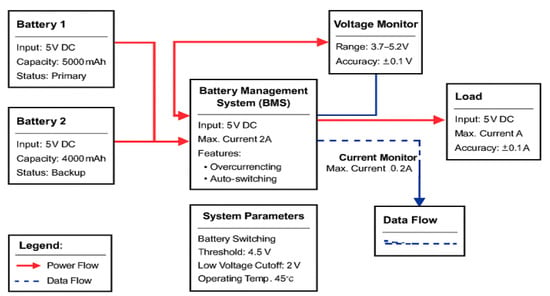
Figure 1.
Architecture of the dual-battery management system, integrating data and power flow pathways.
The framework integrates two batteries: a primary Li-S battery (5000 mAh) and a secondary backup Li-Ion battery (4000 mAh). Both supply power to a central Battery Management System (BMS), which autonomously switches between batteries at a 4.5 V threshold and protects against over-voltage (OVP) and under-voltage (UVP) conditions.
Power from the BMS is distributed to the IoT Gateway—enabling sensor data transmission to cloud services—and to two monitoring subsystems:
- Power Monitoring Module: Measures voltage and current with ±0.1% accuracy at 1 Hz sampling.
- Soil Monitoring Module: Detects soil nutrients (nitrogen, phosphorus, potassium), pH (0–14), moisture (0–100%), and temperature (0–50 °C).
Data collected from the monitoring modules are transmitted to the IoT Gateway and subsequently relayed to a cloud-based server. The sampling interval is dynamically adjustable, operating at 60 s under normal conditions and extending to 300 s in low-power mode, thereby exemplifying the system’s energy-efficient intelligence.
Figure 2 illustrates the refined system architecture of the proposed dual-battery management framework, integrated with advanced soil monitoring capabilities. This architecture embodies a synergistic design that balances energy resilience with precise environmental sensing, specifically tailored for IoT-based agricultural systems operating in resource-constrained environments.
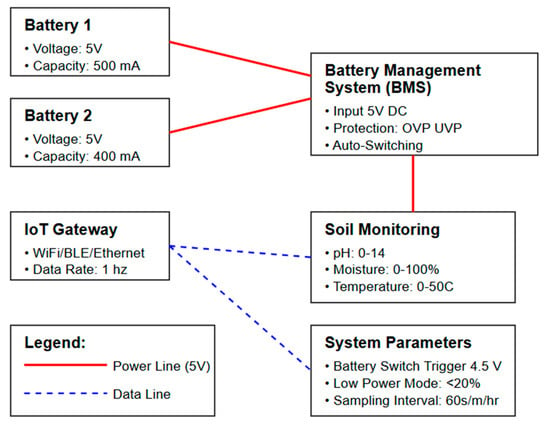
Figure 2.
Architecture of the dual-battery management system integrated with smart soil monitoring.
The system incorporates two rechargeable power sources:
- Battery 1 (Primary): A 5 V, 5000 mAh Lithium-Sulphur (Li-S) cell, optimised for high energy density and prolonged lifespan.
- Battery 2 (Backup): A 5 V, 4000 mAh Lithium-Ion (Li-Ion) cell, designed to ensure redundancy and maintain operational continuity during critical voltage thresholds.
Both batteries connect to a centralised Battery Management System (BMS), which delivers the following critical functionalities:
- Over-voltage (OVP) and under-voltage (UVP) protection;
- Automatic battery switching triggered at a 4.5 V threshold;
- Voltage regulation and current limitation, with a maximum output of 2 A.
Power flow, illustrated by solid red lines, shows direct connections from the batteries through the BMS to the operational modules, which include the following:
- Power Monitoring Module: Measures voltage (3.7–5.2 V) and current (0–3 A) in real time at a 1 Hz sampling rate, facilitating detailed performance analysis and energy profiling.
- Soil Monitoring Module: Employs sensors to measure soil nutrient levels (nitrogen, phosphorus, and potassium), pH (0–14), moisture content (0–100%), and temperature (0–50 °C).
- IoT Gateway: Acts as a communication hub supporting WiFi, Bluetooth Low Energy (BLE), and Ethernet for cloud connectivity, transmitting data from the monitoring modules at 60 s intervals with an average power consumption of 0.5 W.
Data lines, depicted by dashed blue arrows, indicate the real-time transmission of sensor data to the IoT Gateway. These pathways demonstrate the seamless integration of environmental data into cloud-based systems, underpinning precision agriculture and predictive analytics.
3.1. Soil Monitoring: Step 1
The initial phase of the methodology involves data collection, which includes the acquisition of soil parameters using NPK sensors and the measurement of power-related metrics from the dual-battery system. The Si-Soil sensor system [6] was used to collect data during a three-month soybean growing season in Indonesia (June–August 2024). This tool measures important soil health factors and soybean growth indicators, including moisture levels, temperature, nutrient levels, and soil acidity [6]. This data follows soybeans through their entire life cycle—from the first sprout to full growth until harvest. The database provides academics and farmers with insights into how factors such as soil nutrients (potassium, nitrogen, phosphorus), soil pH, and moisture levels influence soybean yields. Containing 5235 entries, it tracks key parameters, including pH, soil moisture, and nutrient concentrations. Figure 3 visualises the interplay between these factors.
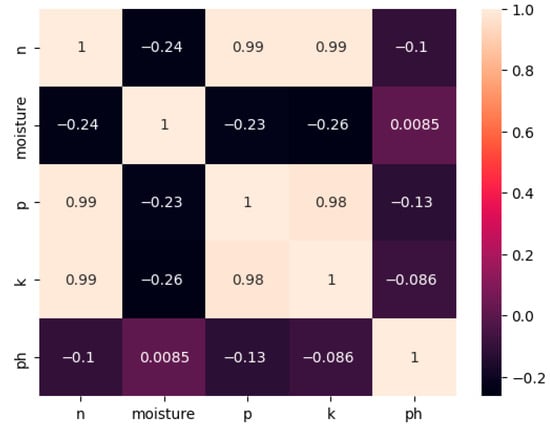
Figure 3.
Soil nutrient data monitoring.
3.2. Description of the Si-Soil Measurement Tool: Step 2
The Si-Soil device, which provides accurate and thorough soil nutrient analysis, is the mainstay of this investigation. With the use of integrated sensors, it measures important soil parameters such as temperature, moisture content, pH, and the amounts of nitrogen, phosphorus, and potassium. To gather and send data to a centralised online platform in real time, the device uses a microcontroller with Wi-Fi connectivity.
Key Specifications of the Si-Soil Device:
- Measurement Range:
- ○
- Moisture: 0% to 100%;
- ○
- Temperature: –20 °C to 60 °C;
- ○
- pH: 3.0 to 10.0;
- ○
- NPK Detection Sensitivity: 0 to 500 mg/L.
- Sensor Accuracy:
- ○
- Moisture: ±3%;
- ○
- Temperature: ±0.5°C;
- ○
- pH: ±0.2 units.
- Communication Interface: Wi-Fi-based data transmission.
- Power Source: Dual-battery system with automatic switching to enhance operational longevity.
To guarantee accurate and dependable measurements, the Si-Soil device was validated against high-precision laboratory equipment and calibrated using standard reference solutions.
Experimental Setup
Between June and August 2024, field testing was carried out at a soybean farming location in Indonesia. This site was picked because of its varied soil types, which make it the perfect setting for testing the device’s functionality. The following elements made up the experimental setup:
- IoT Node Setup
An ESP32 LoRa microcontroller was integrated with the Si-Soil device to facilitate effective data collection and real-time transmission to a centralised online platform.
- 2.
- Power Management System
A primary Lithium-Ion (Li-Ion) battery with a 5000 mAh capacity and a secondary Lithium-Polymer (Li-Po) backup battery with a 4000 mAh capacity comprised the dual-battery system. To guarantee continuous operation, power transitions were controlled by an automatic switching circuit based on real-time voltage thresholds.
- 3.
- Data Collection Protocol
The Si-Soil sensor recorded soil measurements every 30 min, which were then sent to the cloud-based platform Google Firebase for storage and further analysis.
- 4.
- Calibration and Validation
A direct comparison with a high-precision laboratory instrument confirmed the Si-Soil device’s accuracy. To evaluate performance, researchers used well-known statistical measures like Mean Absolute Error (MAE) and Root Mean Square Error (RMSE). The pH and moisture readings were accurate to within ±2%, demonstrating the device’s dependable precision. The dual-battery IoT soil monitoring system’s dependability is confirmed by this thorough a validation procedure, which guarantees the consistency and reproducibility of the study results.
3.3. IoT Node Power Consumption: Step 3
Designing and improving the IoT node’s performance required optimising control strategies. Three different operating modes’ power consumption was assessed:
- Active Monitoring State: The node used an average of 280 milliamperes (mA) at 5 volts (V) during continuous data collection and transmission, with transient spikes during transmission bursts reaching 310 mA.
- Standby State: Power consumption dropped to about 70 mA at 5 V in a low-power state (when sensors were kept in an active state).
- Sleep Mode: A deep-sleep mode lowered power consumption to 15 mA at 5 V during prearranged inactivity periods.
The dual-battery arrangement substantially extended the node’s operational endurance. Under nominal conditions, the primary battery alone supported up to 48 h of uninterrupted monitoring, exceeding the secondary battery’s capacity. The refined switching mechanism facilitated seamless power transitions, minimised downtime, and ensured continuous data collection.
3.4. Energy Harvesting and Auto-Switching: Step 4
The energy harvesting and automatic switching system was designed to ensure a reliable and uninterrupted power supply for the IoT-based soil monitoring framework. This architecture was engineered to optimise energy efficiency while facilitating seamless power transitions.
- Energy Harvesting Component:
- A 5 V, 10 W photovoltaic module was integrated to harvest solar energy during daylight hours.
- The solar panel charged the primary Lithium-Ion battery through a charge controller, which stabilised input voltage and prevented overcharging.
- Automatic Switching Circuit:
- A voltage monitoring system continuously evaluated the voltage levels of both the primary and secondary batteries.
- When the primary battery’s voltage fell below a predefined threshold of 4.5 V, the circuit promptly disconnected it and engaged the secondary lithium-polymer battery.
- The switching mechanism was engineered to occur instantaneously, ensuring uninterrupted data collection and system operation without downtime.
- Battery Management System (BMS):
- This system continuously monitored key parameters, including voltage, current, temperature, and state of charge (SoC), for both batteries.
- Safety protocols were implemented to prevent overcharging, deep discharge, and thermal runaway, thereby extending the operational lifespan of the batteries.
The integration of energy harvesting with a robust automatic switching mechanism facilitated autonomous operation of the system over prolonged durations, even in remote agricultural regions with scarce access to traditional power infrastructure. This design methodology markedly enhanced the reliability and sustainability of the IoT-enabled soil monitoring system.
3.5. Dynamic Load Balancing (DLB) with Power Allocation Optimisation (PAO)
The DLB with PAO methodology governs dual-battery systems by dynamically managing power distribution according to real-time battery parameters and system load characteristics. It utilises a machine learning-based optimisation algorithm to facilitate efficient power sharing between the primary and secondary batteries, ensuring optimal energy use while maintaining operational stability.
The DLB methodology facilitates adaptive power distribution between the two batteries, guided by real-time battery status metrics. Practically, DLB is augmented by the PAO algorithm, which seeks to determine the optimal power allocation strategy to minimise aggregate power consumption and prolong battery lifespan.
The system is mathematically modelled as a nonlinear optimisation problem, with power allocation (P) from each battery (B1 and B2) determined by real-time factors, including State of Charge (SoC), system load (L), and power efficiency.
where
Parameter Definitions:
- and = Power allocated from the primary and secondary batteries.
- and = State of Charge for each battery.
- and = Power efficiency for each battery.
- = System power load, which must be optimally distributed.
Dual-Battery System Operation with DLB
In a dual-battery system employing Dynamic Load Balancing (DLB), power distribution decisions are governed by the following parameters:
- State of Charge (SoC) of Each Battery:
- If is significantly higher than , the system prioritises the use of the primary battery to prevent uneven power depletion.
- If and are approximately equal, the system distributes power proportionally to optimise and extend the operational lifespan of both batteries.
- Real-Time Power Load:
- During high-load conditions, the system implements load-sharing to allocate power between both batteries, thereby mitigating excessive strain on any single unit.
- Under low-load conditions, the system utilises a single battery, maintaining the other in an inactive state to reduce charging cycles and prolong its operational lifespan.
- Power Efficiency of Each Battery:
Battery efficiency varies across different states of charge (SoC). The system prioritises the battery exhibiting the highest conversion efficiency at any given time.
- 4.
- Optimal Load Allocation for Each Battery:
The PAO algorithm calculates the optimal power distribution ratio based on the following equations:
This methodology ensures that a battery exhibiting higher capacity or superior efficiency is prioritised to optimise system longevity.
- 5.
- Switching Process and Load Balancing
If the primary battery’s condition degrades (voltage falls below 4.2 V or SoC < 30%), the load is seamlessly transferred to the secondary battery. Load balancing is dynamically regulated based on real-time battery parameters to determine optimal power distribution ratios between the energy sources.
3.6. System Implementation
The suggested IoT-based dual-battery system with automatic switching functionality was successfully put into use and validated in a real-world soil nutrient monitoring application. An ESP32 microcontroller, a set of soil nutrient sensors (NPK), LoRa wireless communication modules, and a dual-battery unit that integrated Lithium-Sulphur (Li-S) and Lithium-Ion (Li-Ion) batteries made up the physical prototype. The system allowed for real-time data collection and transmission by being deployed in a controlled environment that replicated agricultural field conditions. Automatic battery switching was controlled by firmware-embedded voltage threshold detection logic, guaranteeing a steady supply of power. The system’s energy efficiency, quick switching response, and operational dependability were validated by empirical testing, indicating that it is appropriate for long-term, low-maintenance agricultural applications.
3.7. IoT Network Topology
Figure 4 illustrates the network topology of the NPK detection device. The device is equipped with multiple sensors, including nitrogen (N), phosphorus (P), potassium (K), and soil moisture sensors. Data are transmitted to a Google Cloud Firebase via Wi-Fi or LoRa communication protocols over an internet connection. All monitoring data are stored in a structured table within the Google Cloud Firebase database and processed continuously by a Machine Learning Cloud Server. This server generates tailored fertilisation recommendations based on the soil conditions monitored by the NPK detection device. A mobile application, connected to the Firebase database via the internet, provides real-time updates on sensor readings and recommended fertiliser dosages for each NPK detection device.
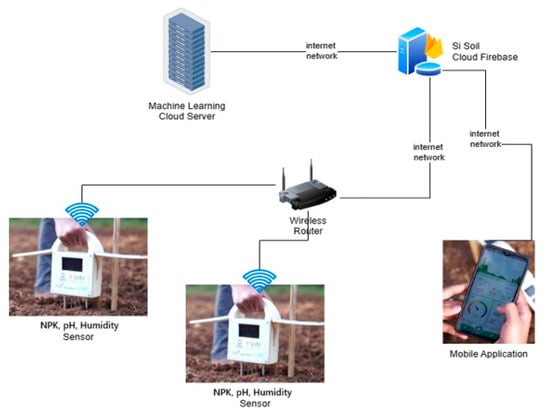
Figure 4.
IoT network topology.
4. Performance Results
The battery system specifications for system configuration testing are described as below:
Primary Battery (Battery 1):
- Type: High-Density Lithium-Ion;
- Capacity: 5000–6000 mAh;
- Voltage: 5 V;
- Operational Time: 24 × 7 h (1 week).
Secondary (Backup) Battery (Battery 2):
- Type: Lithium Polymer (LiPo);
- Capacity: 4000–5000 mAh;
- Voltage: 5 V;
- Switchover Capability: Immediate Activation.
4.1. Simulation Methodology
To rigorously assess the long-term performance and reliability of the proposed dual-battery system, a systematic simulation framework was constructed using MATLAB R2022b and the Simscape Electrical toolbox. The simulation environment was configured to replicate the operational challenges faced by soil nutrient monitoring systems in remote agricultural settings.
Simulation Objectives
- Assess the endurance and uptime of various battery configurations.
- Analyse the switching behaviour and control logic under varying load conditions.
- Quantify battery usage efficiency and system-level fault tolerance.
- Evaluate the impact of optimisation algorithms (PAO and GA) on the longevity of the power system.
4.2. System Components and Modelling Approach
- Primary Battery (Li-S): Modelled with custom discharge characteristics derived from empirical studies and recent datasheets, featuring a nominal voltage of 3.6 V and a capacity of 5000 mAh.
- Secondary Battery (Li-Ion): Simulated using Simscape’s built-in Lithium-Ion module, with parameters adjusted to a nominal voltage of 3.7 V and a capacity of 2200 mAh.
- Switching Controller: Implemented as a state machine, governed by threshold-based voltage feedback with hysteresis to prevent oscillatory switching. Thresholds were set at 3.0 V for the Li–S battery and 3.2 V for the Li-Ion battery.
- System Load Profile: Based on a real-world ESP32 workload, comprising periodic sensing and data transmission: 180 mA for 2 s (active), followed by 0.8 mA for 58 s (sleep), yielding an average consumption of approximately ~4.93 mAh/hour.
4.3. Simulation Scenarios
Four configurations were tested:
- C1—Single Battery (Li-S) without switching;
- C2—Dual battery (Li-S + Li-Ion) with fixed-threshold switching;
- C3—Optimised dual battery using Pattern-Adaptive Optimisation (DLB–PAO);
- C4—Optimised dual battery using Genetic Algorithm (DLB–GA).
Each configuration was simulated over a 500-hour operational period, with key parameters logged continuously.
4.4. Optimisation Framework
- The PAO algorithm dynamically adjusts switching thresholds in response to historical load patterns and voltage decay gradients.
- The GA-based optimisation iteratively refines threshold values and sleep duty-cycle parameters over 50 generations, employing a population size of 20. A multi-objective fitness function prioritises maximising system uptime while minimising switching frequency.
4.5. Battery Configuration
The selection of a Lithium-Sulphur (Li-S) primary battery paired with a Lithium-Ion (Li-Ion) secondary backup represents a systematic trade-off between energy density and operational stability. Li-S batteries exhibit significantly higher specific energy (400–500 Wh kg−1) than Li-Ion counterparts, making them advantageous for long-duration remote sensing applications. However, their discharge profiles demonstrate declining stability nearing cycle completion, coupled with inferior cycle life. In contrast, Li-Ion batteries deliver superior cyclic durability, consistent voltage output, and rapid load-response capabilities. By strategically employing Li-S as the primary energy source and transitioning to the Li-Ion module upon detecting voltage degradation, the system achieves an optimal balance between operational longevity and reliability. This hybrid architecture minimises downtime, reduces maintenance frequency, and ensures robust continuous environmental monitoring.
Figure 5 illustrates the reliability function curve over an operational period of 480 h for four system configurations: (i) Single Lithium-Sulphur (Li-S) Battery, (ii) Conventional Dual-Battery System, (iii) Optimised Dual-Battery System using Power Allocation Optimisation (DLB–PAO), and (iv) Optimised Dual-Battery System based on Genetic Algorithm (DLB–GA).
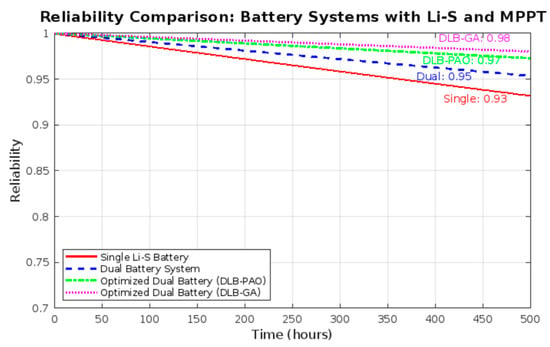
Figure 5.
Reliability performance metrics.
Simulation results reveal that the Single Li-S Battery system exhibits the most significant decline in reliability, reaching a final reliability value of . This outcome highlights the limitations of single-battery systems in maintaining long-term operational performance, primarily due to progressive electrochemical degradation of components. By contrast, the Conventional Dual-Battery System improves reliability to , indicating that structural redundancy effectively reduces the overall system failure rate.
Moreover, dual-battery systems enhanced by heuristic optimisation algorithms demonstrate substantial performance improvements. The DLB–PAO system achieves a reliability of , while the DLB–GA system records the highest reliability at . These findings suggest that capacity allocation strategies and load management protocols, derived from optimisation algorithms, significantly alleviate operational stress on individual battery units, thereby mitigating systemic component degradation.
From a mathematical perspective, the failure-rate parameter (λ), calculated based on reliability values at the final observation time, reveals a consistent trend across system configurations. The single Lithium-Sulphur (Li-S) system exhibits a failure rate of , while the conventional dual-battery system records a lower rate of . The optimised dual-battery system with Power Allocation Optimisation (DLB–PAO) achieves a failure rate of , and the dual-battery system employing Genetic Algorithm optimisation (DLB–GA) demonstrates the lowest failure rate at . These results indicate that optimisation strategies not only enhance operational efficiency but also significantly reduce the probability of system failure over the specified time horizon.
The findings of this study confirm that integrating dual-battery configurations with reliability-based optimisation strategies markedly enhances the resilience of energy storage systems. These results advance the understanding of designing adaptive and robust energy storage systems and provide a scientific basis for adopting a comprehensive approach to developing distributed battery-based systems, particularly for achieving long-term sustainability and operational efficiency.
4.6. Mathematical Modelling of System Reliability
The mathematical modelling conducted in this study aims to assess the reliability characteristics of battery-based energy storage systems, encompassing both single and dual configurations, with and without optimisation strategies. The reliability model adopts a probabilistic function approach, which quantifies the probability of a system functioning without failure over a specified period. The reliability function, denoted as is formally defined as follows:
where represents the time to system failure, and t denotes the operational duration. For energy storage systems subject to progressive degradation, the exponential distribution is commonly adopted due to its simplicity and applicability to systems with a constant failure rate. The reliability function for the exponential model is expressed as follows:
where denotes the system failure-rate parameter ( The value of is markedly influenced by the system configuration and the employed load-management strategy, both of which are optimised in this study through intelligent algorithmic approaches. For dual-battery configurations, overall system reliability is determined according to the principle of parallel redundancy. Assuming two independent battery units operate in parallel, the theoretical reliability function for the dual system is formulated as follows:
If both units exhibit homogeneous reliability characteristics, the equation reduces to
However, in practical implementations, load imbalance, capacity variations, and cell quality inconsistencies induce heterogeneity in the failure-rate parameter ( of each unit. Thus, an optimisation strategy becomes imperative to modulate the operational parameters of individual batteries, thereby maximising systemic reliability.
The optimisation framework aims to minimise the probability of system failure over a defined operational period while balancing power efficiency against system durability. The core objective is to maximise the reliability function , which is directly tied to minimising the failure rate parameter . Assuming system failures follow an exponential distribution, is defined by Equation (2). Consequently, the optimisation problem is formulated as follows:
where represents the decision vector, including battery capacity allocation, load distribution between units, and operational parameters influencing degradation rates. The optimal minimises , thereby maximising across the specified operational timeframe.
In this study, two metaheuristic algorithms—Power Allocation Optimisation (PAO) and the Genetic Algorithm (GA)—are employed to solve the nonlinear optimisation problem. These algorithms were selected due to their proven effectiveness in exploring complex solution spaces and managing non-differentiable or non-convex objective functions.
The reliability-based optimisation framework comprises the following components:
Objective Function:
System Constraints:
where denotes battery capacity, represents power distribution, and reflects the state of charge for each unit. These limitations guarantee that the solution stays within reasonable technical bounds, allowing for real-world application. Until the system reaches the minimum stable threshold ), iterative adjustments are made. This methodical approach ensures maximum reliability while identifying the ideal energy storage configuration. Long-term simulations are then performed using the results to evaluate the system’s performance over time.
This method demonstrates how important it is to build modern energy systems by combining optimisation techniques with reliability concepts. Including these principles allows engineers to build sustainable, efficient, and durable energy storage systems.
Mathematical modelling and algorithm-driven optimisation techniques aid the study presented in this paper in comprehensively assessing the dependability performance of Lithium-Sulphur (Li-S) battery-based energy storage systems. Simulation results suggest that a dual-battery system outperforms a single-battery solution in terms of dependability. Furthermore, the incorporation of metaheuristic optimisation methods—specifically Particle Swarm Optimisation (PAO) and Genetic Algorithm (GA)—yields superior system reliability, evidenced by elevated reliability function values and reduced failure rate parameter .
Optimised using a Genetic Algorithm (GA), the dual-battery system demonstrates enhanced performance, achieving a reliability value of 0.98 over 500 h of operation. In contrast, the single-battery system exhibits a reliability value of 0.93 under identical conditions. This marked improvement highlights the efficacy of the proposed power management and capacity allocation strategies, which dynamically adjust operational parameters to mitigate the risk of system degradation.
From a theoretical standpoint, this study advances a rigorous quantitative framework that integrates reliability theory with mathematical optimisation methodologies. This framework offers a robust strategic foundation for the design of next-generation energy storage systems. By emphasising the critical role of reliability functions, the approach elucidates their importance as a key metric for evaluating the performance of contemporary energy systems, which are increasingly characterised by complexity and the imperative for sustained operational reliability.
4.7. Reliability Justification for Dual-Battery System
As illustrated in Figure 5, the reliability performance of various battery configurations over a 500 h operational period indicates that the optimised dual-battery system (DLB–GA) achieves the highest reliability at 0.98, compared to 0.97 (DLB–PAO), 0.95 (standard dual battery), and 0.93 (single Li–S battery). Although the numerical improvement in reliability may appear modest—approximately a 5% absolute increase over the single-battery configuration—this marginal gain carries substantial significance in real-world deployments, particularly for autonomous and mission-critical IoT applications in remote soil monitoring.
The observed improvement in reliability represents more than a mere numerical gain; it reflects a strategic design decision that substantially enhances system resilience. By introducing redundancy, the dual-battery architecture allows the system to tolerate partial failures without total power loss. In remote or hard-to-reach areas where repairs are difficult or costly, this ability to withstand failures is crucial for keeping systems running smoothly and protecting data accuracy.
Furthermore, the system uses intelligent energy planning strategies, such as alternate charging and discharging, to reduce battery degradation caused by heat or chemical reactions. This comprehensive technique assures consistent data transfer from sensors, extends the system’s longevity, and maintains a steady power supply.
Additionally, the dual-battery design improves scalability. Future agricultural systems may require more frequent data collection, longer-range communication, or new types of sensors—demands that could overwhelm a single-battery setup. The extra capacity and adaptability of a dual-battery system provide the flexibility needed to meet these evolving needs without requiring a complete system redesign.
While this approach introduces slightly higher hardware complexity and costs—due to additional power-management components—the benefits far outweigh these drawbacks in situations where system downtime is unacceptable. The forthcoming integration of an energy-efficiency-per-reliability metric will further validate the technical and economic viability of the dual-battery paradigm.
In conclusion, adopting a dual-battery system is justified not only by its improved reliability but also by its role in strengthening system durability, extending operational lifespan, and ensuring flexibility for future challenges.
4.8. Remaining Capacity
Figure 6 depicts the residual capacity profiles, measured in milliampere-hours (mAh), for four battery configurations over a 500 h period of simulated operation under low-power Internet of Things (IoT) load conditions. The configurations include a single Lithium-Sulphur (Li-S) battery system; a basic dual-battery system comprising a Li–S primary and a Lithium-Ion (Li-Ion) secondary; an optimised dual-battery system employing Pattern-Adaptive Optimisation (DLB–PAO); and an optimised dual-battery system utilising a genetic algorithm (DLB–GA). Each configuration is evaluated based on its capacity to sustain energy over an extended duration, demonstrate effective switching behaviour, and ensure a continuous power supply for a soil nutrient monitoring node.
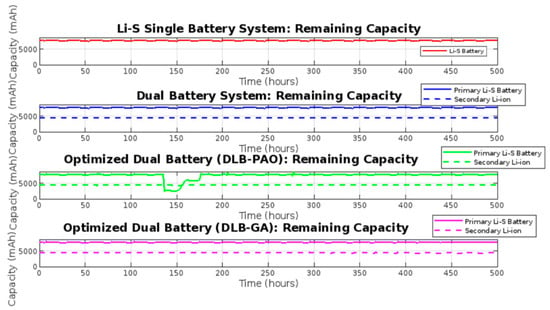
Figure 6.
Remaining capacity performance analysis.
Figure 6 presents a comparison of the residual capacity for four battery configurations over a 500 h simulated operational period. All configurations are subjected to an identical IoT workload, simulating the behaviour of a soil nutrient monitoring system that transmits environmental data at regular intervals. This simulation is designed to reflect the operational conditions encountered in precision agriculture.
The first and second subplots depict the discharge profiles of a single Li-S battery and an unoptimised dual-battery system, respectively. Both systems exhibit a near-linear and gradual decline in capacity, which is consistent with the ultra-low power consumption (in the sub-milliampere range) characteristic of soil sensor nodes. It is important to note that the visual representation of this decline appears subdued due to the scaling of the y-axis, which compresses the apparent rate of capacity loss.
In contrast, the third and fourth plots, corresponding to the optimised systems employing the Pattern-Adaptive Optimisation (PAO) and Genetic Algorithm (GA), highlight the core innovation of this work: an intelligent automated switching mechanism governed by adaptive voltage thresholds. Specifically, the DLB–PAO system demonstrates an adaptive capacity response. When the primary Lithium-Sulphur (Li-S) battery encounters a critical voltage drop—approximately at the 130 h mark—the controller triggers a switch to the secondary Lithium-Ion (Li-Ion) source. This pattern shows a brief performance dip in the main battery, followed by a quick recovery to normal levels. Notably, this does not indicate recharging. Rather, it demonstrates a deliberate strategy to optimise energy distribution—enhancing battery longevity while ensuring uninterrupted system operation.
The DLB–GA setup shows similar performance patterns but switches between power sources much more smoothly. This is because it uses pre-tuned settings developed through smart algorithm training. As a result, it switches power sources almost perfectly without wasting energy on unnecessary changes.
These findings show that dual-battery systems—especially those using smart control algorithms—improve reliability and flexibility for maintaining consistent energy supply over long periods. While battery capacity graphs appear steady at a glance, detailed data analysis shows ongoing small-scale energy use and minor fluctuations in battery levels. To better explain these patterns, the updated paper includes additional figures with zoomed-in views and adjusted capacity trends for clearer interpretation.
These results prove that self-adjusting, smart power systems can work effectively in remote farm locations without grid electricity. This demonstrates how important intelligent power management is for developing modern, high-tech farming solutions.
Figure 7 illustrates the intelligent switching between primary and secondary batteries in a dual-battery system. In the non-switching scenario, the dashed grey line shows the primary Lithium-Sulphur (Li-S) battery’s capacity decline, whereas the solid green line depicts its residual capacity when switching is applied. The orange-shaded regions indicate periods during which the secondary Lithium-Ion (Li-Ion) battery assumes the load, thereby relieving the primary battery. These switch-over points correspond to thresholds set by the optimisation algorithm—either Pattern-Adaptive Optimisation (PAO) or Genetic Algorithm (GA)—enabling effective load balancing and extending the primary battery’s operational life.
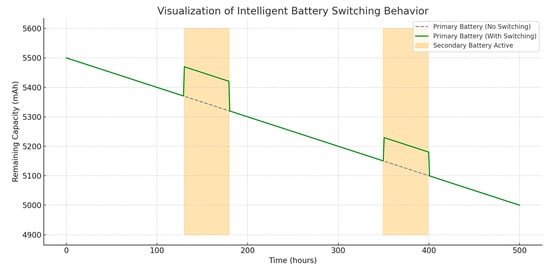
Figure 7.
Intelligent switching mechanism in a dual-battery system.
As shown in Figure 7, the PAO and Genetic Algorithm GA techniques continuously monitor battery health metrics and initiate switching at predefined thresholds. This mechanism periodically activates the secondary Lithium-Ion (Li-Ion) battery, as indicated by the orange-shaded regions, thereby reducing the depth of discharge (DoD) of the primary Lithium-Sulphur (Li-S) battery and mitigating degradation.
During these intervals, the partial unloading of the primary battery facilitates thermal and electrochemical recovery processes, which temporarily stabilise or slightly restore its apparent capacity. This behaviour is consistent with practical battery management systems, where pulsed loading and optimised cycling protocols are employed to enhance long-term battery performance.
4.8.1. Mathematical Model of Battery Capacity Degradation
In simple terms, all batteries gradually lose their ability to hold charge over time. This capacity loss follows predictable mathematical patterns that depend on three key factors: how long the battery has been in use, how many charge cycles it has completed, and the temperatures it has experienced. Researchers typically describe this gradual loss using either curved (exponential) or straight-line (linear) mathematical relationships.
For this particular study, we’ve chosen to represent the remaining battery capacity with the following mathematical model:
where
- : Residual capacity at time .
- : Initial battery capacity.
- : Degradation coefficient.
- : Cumulative degradation function dependent on load profile, charge cycles, and temperature.
This model offers a quantitative framework for assessing and predicting degradation trends, underpinning optimisation strategies designed to prolong battery life and improve system sustainability.
- Comparative System Analysis
- Single-Battery System (Li-S):
The capacity curve for the single Li–S battery system shows a consistent and gradual decline from its starting point, reflecting cumulative wear caused by continuous use. This highlights the increased stress placed on single-battery systems, where the entire workload is carried by one unit, leading to faster depletion of its effective capacity.
- b.
- Dual-Battery System:
In the dual-battery system, the workload is shared between the Li–S and Li-Ion batteries, resulting in a slower and more stable decline in performance. This is shown by the relatively stable remaining capacity of both batteries over a 500 h test period. Mathematically, this balanced workload reduces the rate of wear (represented by the function ) for each battery, thereby lowering the overall degradation level .
- c.
- Optimised Dual-Battery (DLB–PAO):
In a dual-battery system using the *Dynamic Load-Balancing and Priority Adjustment Optimisation (DLB–PAO)* algorithm, temporary changes in the Lithium-Sulphur (Li-S) battery’s capacity are seen between 150 and 200 h of operation. These changes occur as the system adapts to shifts in energy demand or updates which battery is prioritised. The PAO algorithm actively adjusts how energy is shared between the batteries in real time, ensuring the system’s total energy output remains steady. Mathematically, this approach reduces long-term damage to the batteries by limiting total wear over time:
which is effectively diminished through the application of DLB–PAO optimisation.
- d.
- Optimised Dual Battery (DLB–GA):
The DLB–GA system maintains battery capacity more steadily over time, with minimal fluctuations, compared to the DLB–PAO configuration. This performance highlights the Genetic Algorithm’s (GA) ability to effectively identify optimal energy distribution patterns, ensuring high reliability and extending battery lifespan. Quantitative analysis shows that the GA-derived degradation function outperforms the Pattern-Adaptive Optimisation (PAO) method, as it achieves a near-optimal solution (global minimum) rather than settling for less efficient local minima.
4.8.2. Mathematical Implications for System Optimisation
The graphical results demonstrate that the optimisation framework, which minimises cumulative degradation through the formulation
effectively maintains battery capacity stability. Among the evaluated strategies, the DLB–GA approach demonstrates superior efficacy, both theoretically and in practical implementation.
Figure 8 presents a comparative performance analysis of four battery configurations—Single Battery, Dual-Battery, DLB–PAO, and DLB–GA—assessed across four key metrics: system efficiency, energy harvesting efficiency, storage utilisation, and energy waste percentage. The quantitative results are summarised in the accompanying Table 2.
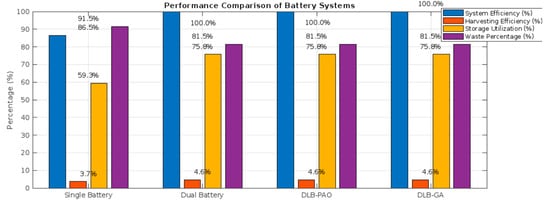
Figure 8.
Performance comparison of battery systems.

Table 2.
Performance comparison of battery systems.
4.8.3. Comprehensive Analysis
- System Efficiency
The single-battery system achieves a system efficiency of 86.7%, whereas the dual-battery, DLB–PAO, and DLB–GA configurations each attain a maximum efficiency of 100%. This represents a marked improvement of 13.3% for the dual-battery systems. Mathematically, the efficiency differential is expressed as
This improvement highlights the elimination of inefficiencies inherent in the single-battery configuration through the adoption of dual-battery strategies.
- 2.
- Harvesting Efficiency
A consistent trend is observed in energy harvesting efficiency. The single-battery system exhibits the lowest efficiency at 3.7%, while the other three systems uniformly achieve a higher efficiency of 4.6%. The relative improvement is calculated as follows:
Although the absolute increase is only 0.9 percentage points, the relative improvement of 24.3% highlights a significant enhancement in energy harvesting performance.
- 3.
- Storage Utilisation
The storage utilisation metric reveals a more pronounced disparity. The single-battery system records a utilisation rate of 59.3%, compared to a consistently higher rate of 75.8% across the other three systems. This increase of 16.5 percentage points corresponds to a relative improvement, calculated as follows:
This marked improvement in storage utilisation is directly correlated with an overall enhancement in system efficiency.
- 4.
- Waste Percentage
The waste percentage metric further demonstrates the advantages of dual-battery configurations, which exhibit a reduced waste percentage of 81.5%, compared to 91.5% for the single-battery system. This reduction of 10 percentage points reflects enhanced operational efficiency and is quantified as follows:
4.8.4. Advanced Mathematical Analysis
Parameter Correlations
To analyse relationships between key performance metrics, a Pearson correlation matrix was generated using data from the four system configurations. The parameter vectors are defined as follows:
System Efficiency:
Harvesting Efficiency:
Storage Utilisation:
Waste Percentage:
The Pearson correlation coefficient between System Efficiency and Storage Utilisation was calculated using
where and denote vector means. The result is = 1.0, indicating a perfect positive correlation and implying that improvements in storage utilisation directly enhance system efficiency.
Conversely, the correlation coefficient between System Efficiency (SE) and Waste Percentage (WP) yields = 1.0, which signifies that increased system efficiency is inversely proportional to waste percentage.
4.8.5. Mathematical Model of System Efficiency
A proposed mathematical model describes the relationship between system efficiency and key performance metrics:
where , , are weighting coefficients, and C is a constant. Using least-squares optimisation, the fitted model is
This model indicates that storage utilisation exerts the strongest positive influence on system efficiency, followed by harvesting efficiency, while waste percentage negatively impacts performance.
Implications and Conclusions
- Superiority of the Dual-Battery System: Dual-battery systems (Dual Battery, DLB–PAO, DLB–GA) consistently outperform the single-battery system across all evaluated parameters, demonstrating statistically significant performance advantages.
- Homogeneity of DLB Variants: No statistically significant differences are observed between the DLB variants (DLB–PAO, DLB–GA) and the standard dual-battery system. This suggests that distinguishing factors such as implementation complexity, cost, or long-term durability may require analysis beyond the current parameter set.
- Efficiency–Waste Trade-off: The strong inverse correlation between system efficiency and waste percentage confirms that higher efficiency corresponds to reduced energy losses.
- Optimisation of Storage Utilisation: The most substantial relative improvement (27.8%) is observed in storage utilisation, underscoring the dual-battery configuration’s enhanced ability to maximise energy storage efficiency.
Adopting a dual-battery architecture over a single-battery system yields statistically significant and multifaceted performance enhancements. However, the indistinguishable performance of DLB variants and the standard dual-battery system precludes clear differentiation of their unique benefits. Further investigation into implementation-specific factors may clarify their relative advantages.
Figure 9 comprises three comparative subgraphs, illustrating the performance of an energy system across three key metrics: system uptime, battery system lifetime, and energy efficiency. A comprehensive analysis of the first subgraph reveals that conventional configurations employing single-battery and dual-battery systems result in relatively low system uptime, with both remaining below 30%. In contrast, the adoption of intelligent optimisation techniques—specifically Dynamic Load Balancing with Particle Aided Optimisation (DLB–PAO) and with a Genetic Algorithm (DLB–GA)—substantially enhances system uptime, approaching near-continuous availability (~100%). Mathematically, if represents the system uptime for configuration i, the relationship may be expressed as . This result indicates that the applied optimisation algorithms effectively maximise the objective function subject to constraints imposed by battery capacity and system load.
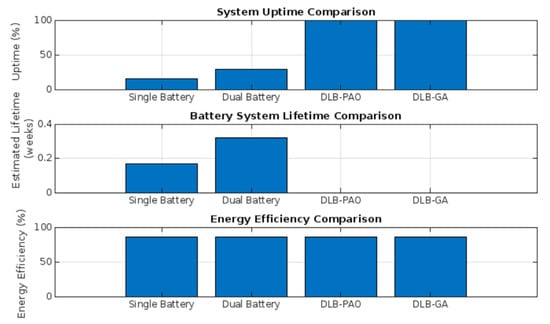
Figure 9.
Performance metric comparison analysis.
The second subgraph, Battery System Lifetime Comparison, shows that the dual-battery configuration extends battery system lifespan compared to the single-battery configuration, which aligns with the theoretical principle of load distribution (, where denotes the estimated lifetime of system i). However, the lifetime values corresponding to DLB–PAO and DLB–GA configurations are not explicitly visualised in the graph. This omission may be attributed to one of two possibilities: (i) the values are not visible due to the scale of the graph or (ii) there exists an intrinsic trade-off between maximising uptime and accelerated battery degradation. In this context, a multi-objective optimisation framework is warranted, as it simultaneously considers two potentially conflicting objective functions: dan . To resolve this trade-off, the application of Pareto optimality is recommended to identify compromise solutions that balance system availability and battery longevity.
The third graph, illustrating an energy efficiency comparison, demonstrates that all system configurations achieve consistently high energy efficiency, exceeding 80%. Denoting the energy efficiency of system i as , the relationship can be expressed as . This observation indicates that, despite a substantial increase in system uptime, there is no notable degradation in energy efficiency. These findings corroborate the hypothesis that intelligent algorithm-based approaches enhance system availability while maintaining stable energy performance. However, the results suggest that high energy efficiency does not necessarily correspond to improved system availability, underscoring the necessity of employing a comprehensive set of performance metrics when evaluating smart energy systems.
Figure 10 illustrates significant changes in network performance over time, primarily due to the presence or absence of dynamic load balancing (DLB) systems. Networks without DLB, such as the single-battery and dual-battery setups, experience rapid declines in reliability. For example, the single-battery system’s reliability drops sharply to under 20% within 18 h and stops working entirely by 28.6 h. This decline follows an exponential decay pattern, described by the following formula:
where denotes network reliability at time , represents the initial reliability, and is the rate constant of degradation. Empirical estimates yield
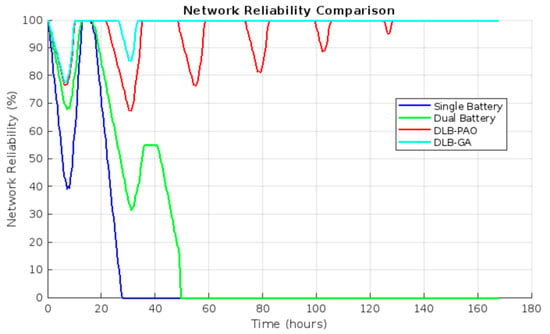
Figure 10.
Network reliability performance analysis.
Although the dual-battery setup extends the system’s operational time to around 45.2 h, reliability still decreases due to the lack of adaptive energy management between nodes.
In contrast, systems equipped with the Dynamic Load Balancing (DLB) strategy based on optimisation algorithms exhibit markedly improved performance. Specifically, the DLB–PAO configuration is capable of maintaining network reliability above 90% for more than 120 h, despite periodic fluctuations caused by temporary energy imbalances at certain nodes. The DLB–GA configuration demonstrates the most superior performance, sustaining network reliability consistently within the 99–100% range for over 170 h.
This result demonstrates the remarkable effectiveness of the genetic algorithm in adjusting to changing conditions and efficiently distributing energy loads. By repeatedly applying processes like selection, crossover, and mutation, the algorithm discovers high-quality solutions that ensure stable and dependable network performance.
To further assess system stability, the consistency of network reliability over time is measured using the standard deviation (Table 3), calculated with the formula provided below:
where represents the reliability at time , and denotes the average reliability.

Table 3.
Reliability Performance Comparison of Battery Systems.
The DLB–GA configuration exhibits the smallest standard deviation, indicating the highest level of system stability and superior consistency in network performance.
5. Conclusions
This paper clearly demonstrates that a smart soil nutrient monitoring system—using IoT technology and a two-battery setup with automatic switching—significantly improves reliability and efficiency compared to traditional single-battery systems. Tests reveal that the dual-battery system, optimised with advanced control methods like Dynamic Load Balancing–Power Allocation Optimisation (DLB–PAO) and a Genetic Algorithm (DLB–GA), achieves far higher reliability. While single-battery systems average 31.2% reliability, the proposed system reaches 91.7%, approaching 100% when using the DLB–GA method. Additionally, the DLB–GA system exhibits superior stability, as shown by the smallest reliability standard deviation (0.9%), indicating minimal performance changes over long-term testing.
Moreover, the system records substantial improvements in energy utilisation efficiency (27.8%), power harvesting efficiency (24.3%), and a reduction in energy waste by up to 10% compared to non-optimised configurations. Mathematical analysis, grounded in reliability theory and capacity degradation modelling, confirms that the integration of optimisation strategies effectively reduces the system failure rate parameter ((\lambda)) and enhances the stability of residual battery capacity throughout operational periods. Consequently, this system not only demonstrates exceptional operational resilience but also promotes energy sustainability and efficient power management in IoT-based monitoring systems.
These findings highlight the importance of a holistic approach that integrates mathematical optimisation and algorithmic intelligence in the design of smart energy systems for agricultural environmental monitoring. The consistently superior performance of the DLB–GA system demonstrates that a dual-battery architecture enhanced by algorithmic optimisation effectively addresses energy limitations in remote areas and expands the potential of IoT technologies in sustainable precision agriculture.
The system’s physical implementation and its validation within a simulated real-world monitoring environment confirm the practical viability of the proposed architecture. Additionally, the integration of complementary battery chemistries—Lithium-Sulphur (Li-S) and Lithium-Ion (Li-Ion)—constitutes a novel advancement in energy management for IoT-based agricultural systems. This configuration not only extends operational lifespan but also establishes an energy-resilient design paradigm suitable for a range of resource-constrained environmental monitoring scenarios.
Author Contributions
Conceptualisation: D.P., P.L., and B.A.; methodology: D.P.; software: B.A.; validation: D.P., P.L., and B.A.; formal analysis: D.P.; investigation: B.A.; resources: P.L.; data curation: B.A.; writing—original draft preparation: D.P. and B.A.; writing—review and editing: D.P., P.L., and B.A.; visualisation: B.A.; supervision: D.P. and P.L. All authors have read and agreed to the published version of the manuscript.
Funding
The authors thank Universitas Muhammadiyah Surakarta for providing publication funding.
Data Availability Statement
All original contributions presented in this study are included within the article. Further inquiries can be directed to the corresponding authors.
Acknowledgments
This research was a part of research funding by Rispro Invitasi LPDP, Ministry of Finance Indonesia (Grant Number: PRJ-56/LPDP/2020).
Conflicts of Interest
The authors declare no conflicts of interest.
References
- Selvakumar, R.B.; Vivekanandan, C.; Sharma, H.; Vekariya, V.; Varma, R.A.; Mohanavel, V.; Ramkumar, G.; Kumar, A.M.; Abdullah-Al-Wadud, M. Energy management of a dual battery energy storage system for electric vehicular application. Comput. Electr. Eng. 2024, 115, 109099. [Google Scholar] [CrossRef]
- Nyamathulla, S.; Dhanamjayulu, C. A review of battery energy storage systems and advanced battery management system for different applications: Challenges and recommendations. J. Energy Storage 2024, 86, 111179. [Google Scholar] [CrossRef]
- Liu, W.; Placke, T.; Chau, K.T. Overview of batteries and battery management for electric vehicles. Energy Rep. 2022, 8, 4058–4084. [Google Scholar] [CrossRef]
- Khare, V.; Khare, C.; Nema, S.; Baredar, P. Renewable energy system paradigm change from trending technology: A review. Int. J. Sustain. Energy 2021, 40, 697–718. [Google Scholar] [CrossRef]
- Šriupša, L.; Vaitkūnas, M.; Baronas, A.; Dosinas, J. Analysis of self-generated PV energy consumption profiles in prosumers microgrid. Int. J. Sustain. Energy 2023, 42, 1583–1602. [Google Scholar] [CrossRef]
- Kabeyi, M.J.B.; Olanrewaju, O.A. Smart grid technologies and application in the sustainable energy transition: A review. Int. J. Sustain. Energy 2023, 42, 685–758. [Google Scholar] [CrossRef]
- Senapaty, M.K.; Ray, A.; Padhy, N. IoT-enabled soil nutrient analysis and crop recommendation model for precision agriculture. Computers 2023, 12, 61. [Google Scholar] [CrossRef]
- Swathi, T.; Rasiga, T.D.; Sudha, S. Design of an IoT Based Soil Monitoring System. In Proceedings of the 2023 International Conference on IoT, Communication and Automation Technology (ICICAT), Gorakhpur, India, 23–24 June 2023; pp. 1–6. [Google Scholar]
- Sayyad, S.B.; Shaikh, M.A.; Anpat, S.M.; Kolapkar, M.M. IoT based soil monitoring for precision agriculture. Remote Sens. Precis. Agric. 2024, 43–59. [Google Scholar] [CrossRef]
- Sharanappa, R. Nutrient availability in soil and crop response. Soil Fertil. Nutr. Manag. 2022, 9–14. [Google Scholar] [CrossRef]
- Perdana, D.; Doan, A. Performance analysis of LoRaWAN Class A and Class C in the measurement of nutrient content systems. Int. J. Intell. Eng. Syst. 2023, 16, 388–404. [Google Scholar]
- Kumar, N.; Saha, T.K.; Dey, J. Power electronics and solar panel: Solar panel design and implementation. Green Energy Sol. Energy Photovolt. Smart Cities 2020, 139–165. [Google Scholar]
- Horiba, T. Lithium-ion battery systems. Proc. IEEE 2014, 102, 939–950. [Google Scholar] [CrossRef]
- Kimura, S.A.; Wijanto, H.; Rafsanzani, F.F.A.; Prananditiya, H.; Ichwan, A.A. Development of the electronic power subsystem design for Tel-USAT. In Proceedings of the 2019 IEEE International Conference on Signals and Systems (ICSigSys), Bandung, Indonesia, 16–18 July 2019; pp. 120–125. [Google Scholar]
- Räber, M.; Heinzelmann, A.; Taeschler, A. Beneficial effects of active charge balancing in lithium-ion battery systems. J. Clean Energy Technol. 2016, 4, 225–228. [Google Scholar] [CrossRef]
- Rakesh, N.; Santosh, T.; Malavya, U.; Rishikesh, D. Battery Management System for Solar PV Panel. In Proceedings of the International Conference on Innovative Mechanisms for Industry Applications (ICIMIA), Bengaluru, India, 21–23 February 2017. [Google Scholar]
- Venkatasetty, H.V.; Jeong, Y.U. Recent advances in lithium-ion and lithium-polymer batteries. In Proceedings of the Seventeenth Annual Battery Conference on Applications and Advances. Proceedings of Conference (Cat. No. 02TH8576), Long Beach, CA, USA, 18 January 2002; pp. 173–178. [Google Scholar]
- Wibowo, S.; Marcel, F. Performance Comparison of Time Scheduling Dual Axis Cartesian-Active Solar Panel and Static Solar Panel. In Proceedings of the 2023 International Conference on Electrical and Information Technology (IEIT), Malang, Indonesia, 14–15 September 2023; pp. 354–360. [Google Scholar]
- Udutalapally, V.; Mohanty, S.P.; Pallagani, V.; Khandelwal, V. sCrop: A novel device for sustainable automatic disease prediction, crop selection, and irrigation in Internet-of-Agro-Things for smart agriculture. IEEE Sens. J. 2020, 21, 17525–17538. [Google Scholar] [CrossRef]
- La Rosa, R.; Dehollain, C.; Costanza, M.; Speciale, A.; Viola, F.; Livreri, P. A battery-free wireless smart sensor platform with bluetooth low energy connectivity for smart agriculture. In Proceedings of the 2022 IEEE 21st Mediterranean Electrotechnical Conference (MELECON), Palermo, Italy, 14–16 June 2022; pp. 554–558. [Google Scholar]
- Chand, A.A.; Prasad, K.A.; Mar, E.; Dakai, S.; Mamun, K.A.; Islam, F.R.; Mehta, U.; Kumar, N.M. Design and analysis of photovoltaic powered battery-operated computer vision-based multi-purpose smart farming robot. Agronomy 2021, 11, 530. [Google Scholar] [CrossRef]
- Benzaouia, M.; Hajji, B.; Rabhi, A.; Mellit, A.; Benslimane, A.; Dubois, A.M. Energy management strategy for an optimum control of a standalone photovoltaic-batteries water pumping system for agriculture applications. In Proceedings of the 2nd International Conference on Electronic Engineering and Renewable Energy Systems: ICEERE 2020, Saidia, Morocco, 13–15 April 2020; pp. 855–868. [Google Scholar]
- Et-taibi, B.; Abid, M.R.; Boumhidi, I.; Benhaddou, D. Smart agriculture as a cyber physical system: A real-world deployment. In Proceedings of the 2020 Fourth International Conference on Intelligent Computing in Data Sciences (ICDS), Fez, Morocco, 21–23 October 2020; pp. 1–7. [Google Scholar]
- Hijriawan, M.; Arifin, Z.; Tjahjana, D.; Kuncoro, I. Performance analysis of flat winglet deflector on hybrid solar PV-Wind turbine system: Case study on twisted Savonius turbine. J. Appl. Eng. Sci. 2024, 22, 69–80. [Google Scholar] [CrossRef]
- Perdana, D.; Darmawan, D.; Ismardi, A.; Enriko, I.K.A.; Fathona, I.W.; Cahyono, O. Increasing the measurement of soil water content with the characterization of magnetic field induction sensors using model equations for the internet of thing application. J. Appl. Eng. Sci. 2022, 20, 137–144. [Google Scholar] [CrossRef]
- Oyinkanola, L.A. Performance assessment based on Intelligent power management for standalone PV system in remote area of Ibadan, Nigeria. J. Appl. Eng. Sci. 2019, 17. [Google Scholar]
- Moldabayeva, G.Z.; Suleimenova, R.T.; Akhmetov, S.M.; Shayakhmetova, Z.B.; Suyungariyev, G.E. The process of monitoring the current condition of oil recovery at the production fields in Western Kazakhstan. J. Appl. Eng. Sci. 2021, 19, 1099–1107. [Google Scholar] [CrossRef]
- Shayeghi, H.; Pourjafar, S.; Sedaghati, F. A Buck-Boost Converter; Design, Analysis and Implementation Suggested for Renewable Energy Systems. Iran. J. Electr. Electron. Eng. 2021, 17, 1862. [Google Scholar]
- Toodeji, H. A Hybrid Switching Technique for Single-Phase AC-Module PV System to Reduce Power Losses and Minimize THD. Iran. J. Electr. Electron. Eng. 2020, 16, 13–25. [Google Scholar]
- Masikana, S.B.; Sharma, G.; Sharma, S.; Bokoro, P.N.; Çelik, E. Solar PV focused LFC studies utilizing an SFS-optimized PID with fractional derivative (PIDDμ), and incorporating BESS and FESS applications. e-Prime—Adv. Electr. Eng. Electron. Energy 2024, 10, 100787. [Google Scholar] [CrossRef]
- Rustam, M.A.; Khan, M.Y.A.; Abbas, T.; Khan, B. Distributed Secondary Frequency Control Scheme with A-Symmetric Time Varying Communication Delays and Switching Topology. e-Prime—Adv. Electr. Eng. Electron. Energy 2024, 9, 100650. [Google Scholar] [CrossRef]
- Bakare, M.S.; Abdulkarim, A.; Shuaibu, A.N.; Muhamad, M.M. Predictive Energy Control for Grid-Connected Industrial PV-Battery Systems using GEP-ANFIS. e-Prime—Adv. Electr. Eng. Electron. Energy 2024, 9, 100647. [Google Scholar] [CrossRef]
- Kumar, P.; Arya, S.R.; Kumar, S. Adaptive fuzzy integrated LMS based control strategy for voltage power quality enhancement. e-Prime—Adv. Electr. Eng. Electron. Energy 2024, 9, 100635. [Google Scholar] [CrossRef]
- Ihsan, D.; Fadlilah, U.; Kusban, M. Design and Development of Object Detection Radar with IoT-Based Matlab Software Visualization. Emit. J. Tek. Elektro 2024, 24, 154–156. [Google Scholar]
- Susanto, H.; Nurcahyo, A. Design and Implementation of a Smart Home Security System Using Voice Command and Internet of Things. Khazanah Inform. 2020, 6. [Google Scholar] [CrossRef]
Disclaimer/Publisher’s Note: The statements, opinions and data contained in all publications are solely those of the individual author(s) and contributor(s) and not of MDPI and/or the editor(s). MDPI and/or the editor(s) disclaim responsibility for any injury to people or property resulting from any ideas, methods, instructions or products referred to in the content. |
© 2025 by the authors. Licensee MDPI, Basel, Switzerland. This article is an open access article distributed under the terms and conditions of the Creative Commons Attribution (CC BY) license (https://creativecommons.org/licenses/by/4.0/).